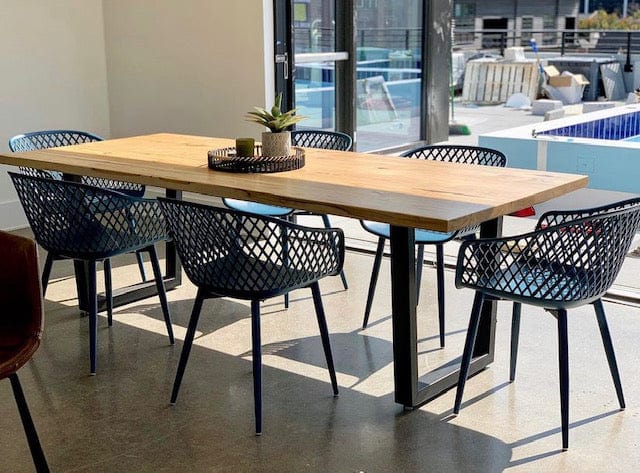The Ultimate Overview to Picking the Finest Designs for Table Legs
Selecting the ideal styles for eating table legs is a nuanced procedure that calls for balancing visual charm with functional considerations. Customized choices use a possibility for personal expression, guaranteeing your table comes to be a distinct focal factor.
Modern Table Legs
In the realm of modern furniture design, modern-day table legs stand out for their smooth and ingenious visual appeals. Identified by tidy lines and minimalist forms, these legs commonly use products such as stainless-steel, chrome, and solidified glass to produce a sophisticated visual appeal. Not just do they enhance the general style of the table, but they additionally contribute to its structural stability and functional versatility.
One of the essential attributes of modern eating table legs is their versatility to various table tops, from marble and glass to timber and engineered surfaces. Designers often experiment with geometric shapes, consisting of angular, tapered, and also sculptural forms, to add a distinct touch per piece. This method not just makes certain a contemporary look however additionally enables higher personalization to match specific preferences and indoor style.
Modern dining table legs also emphasize simplicity of upkeep and resilience. Therefore, contemporary dining table legs embody both form and feature, making them a prominent option in today's style landscape.
Rustic Farmhouse Designs
While modern dining table legs captivate with their streamlined, minimal styles, rustic farmhouse styles use a contrasting yet similarly compelling approach to furnishings aesthetics. Rooted in simpleness and functionality, rustic farmhouse table legs frequently include durable, solid timber buildings that evoke a sense of heat and custom. These designs typically integrate recovered or troubled wood, adding personality and a vintage appeal to any type of eating area.
One of one of the most distinguishing attributes of rustic farmhouse table legs is their considerable, durable look. Typically crafted from oak, pine, or other hardy timbers, these legs can include a selection of shapes, from straight and square to elegantly transformed or tapered styles (dining room table legs). The craftsmanship stresses sturdiness, with hand-finished information that highlight the natural grain and blemishes of the wood, making each item distinctively gorgeous
In addition, rustic farmhouse legs frequently use time-honored joinery strategies, such as mortise and tenon joints, making certain security and longevity. This style is particularly appropriate for developing a comfortable, welcoming atmosphere, excellent for household celebrations and communal dining experiences. By incorporating rustic farmhouse table legs, one can easily blend capability with nostalgic looks, achieving a timeless charm that improves the dining atmosphere.
Timeless and Classic Designs
Enduring elegance defines traditional and classic dining table leg designs, perfectly blending practice with sophistication. These designs catch the essence of withstanding beauty, typically including detailed workmanship that pays homage to historical styles while preserving a contemporary charm (dining room table legs). The aesthetic equilibrium attained via such legs guarantees they remain relevant and trendy across different interior settings, from conventional to contemporary homes

Additionally, the versatility of classic eating table legs permits them to complement different tabletop layouts, developing a cohesive and harmonious dining experience. Their ageless nature makes certain that they withstand altering patterns, making them a useful investment for any dining area. Whether you look for underrated refinement or grand appeal, traditional table legs supply a perfect mix of type and function, improving the general visual of your eating area.
Personalized and One-of-a-kind Options
When it comes to dining table leg styles, custom-made and unique options offer a distinctive way to showcase personal preference and creative thinking. These Related Site selections allow home owners and developers to relocate past standard layouts, producing a table that genuinely shows private style and the overall theme of the eating room. click now Personalized legs can be crafted in a myriad of forms, sizes, and patterns, from elaborate carvings to modern-day geometric kinds, making it possible for limitless opportunities.
Unique table legs can act as a centerpiece in a room, drawing focus and sparking discussion. For instance, legs made to appear like tree branches can bring a touch of nature inside, while sculptural metal legs can impart a modern and industrial panache. Another popular fad is integrating mixed media, such as incorporating timber with metal or glass, to produce a striking contrast and included visual interest.
Material and End Up Selections
Picking the appropriate product and coating for eating table legs is vital to attaining the wanted visual and functionality. The option of products can substantially affect the table's toughness, maintenance, and general design. Typical materials for eating table legs consist of wood, steel, and acrylic.
Timber stays an ageless choice, offering heat and adaptability. Maple, oak, and walnut are prominent choices due to their robustness and abundant structures. Metal legs, such as those made from stainless-steel or iron, give a contemporary and industrial appearance. They are understood for their strength and reduced upkeep. Acrylic legs, although less traditional, provide a contemporary and ventilated feel, ideal read the full info here for smaller sized spaces or minimal styles.
The surface used to the legs additionally refines their appearance and longevity. Timber legs can be stained to boost their natural grain or repainted for a more consistent appearance. Metal legs could be polished for a smooth surface or powder-coated for added security versus wear and corrosion. Polymer legs generally call for marginal completing yet take advantage of routine cleansing to maintain their clearness.
Eventually, the option of material and finish must straighten with the table's overall style, usage demands, and the existing decor of the dining area.
Verdict
The choice of dining table legs considerably impacts the aesthetic and functionality of a dining room. Modern designs use smooth, minimalist appeal, while rustic farmhouse designs provide heat and personality. Cautious consideration of these factors ensures an unified and visually appealing eating location.